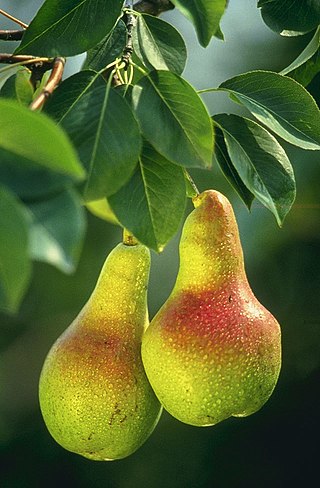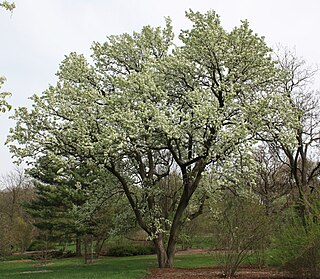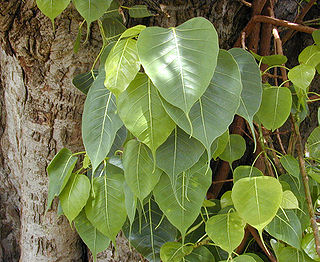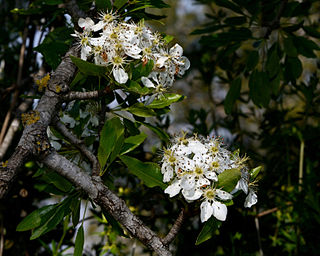
Pears are fruits produced and consumed around the world, growing on a tree and harvested in the Northern Hemisphere in late summer into October. The pear tree and shrub are a species of genus Pyrus, in the family Rosaceae, bearing the pomaceous fruit of the same name. Several species of pears are valued for their edible fruit and juices, while others are cultivated as trees.

Ficus is a genus of about 850 species of woody trees, shrubs, vines, epiphytes and hemiepiphytes in the family Moraceae. Collectively known as fig trees or figs, they are native throughout the tropics with a few species extending into the semi-warm temperate zone. The common fig (F. carica) is a temperate species native to southwest Asia and the Mediterranean region, which has been widely cultivated from ancient times for its fruit, also referred to as figs. The fruit of most other species are also edible though they are usually of only local economic importance or eaten as bushfood. However, they are extremely important food resources for wildlife. Figs are also of considerable cultural importance throughout the tropics, both as objects of worship and for their many practical uses.

Allium ursinum, known as wild garlic, ramsons, cowleekes, cows's leek, cowleek, buckrams, broad-leaved garlic, wood garlic, bear leek, Eurasian wild garlic or bear's garlic, is a bulbous perennial flowering plant in the amaryllis family Amaryllidaceae. It is native to Europe and Asia, where it grows in moist woodland. It is a wild relative of onion and garlic, all belonging to the same genus, Allium. There are two recognized subspecies: A. ursinum subsp. ursinum and A. ursinum subsp. ucrainicum.

Pyrus calleryana, or the Callery pear, is a species of pear tree native to China and Vietnam, in the family Rosaceae. It is most commonly known for its cultivar 'Bradford' and its offensive odor, widely planted throughout the United States and increasingly regarded as an invasive species.

Ficus religiosa or sacred fig is a species of fig native to the Indian subcontinent and Indochina that belongs to Moraceae, the fig or mulberry family. It is also known as the bodhi tree, pimple tree, peepul tree, peepal tree, pipala tree, ashvattha tree, or Asathu (ඇසතු) in Sinhala The sacred fig is considered to have a religious significance in three major religions that originated on the Indian subcontinent, Hinduism, Buddhism and Jainism. Hindu and Jain ascetics consider the species to be sacred and often meditate under it. This is the tree species under which Gautama Buddha is believed to have attained enlightenment. The sacred fig is the state tree of the Indian states of Odisha, Bihar and Haryana.
Grias cauliflora, the anchovy pear, is a fruit native to Jamaica, Central America, and Colombia. It is often found near rivers or marshes in large colonies. It grows on the evergreen tree Grias cauliflora of the Lecythidaceae family.

Allium canadense, the Canada onion, Canadian garlic, wild garlic, meadow garlic and wild onion is a perennial plant native to eastern North America from Texas to Florida to New Brunswick to Montana. The species is also cultivated in other regions as an ornamental and as a garden culinary herb. The plant is also reportedly naturalized in Cuba.

Pyrus salicifolia is a species of pear, native to the Middle East. It is widely grown as an ornamental tree, almost always as a pendulous cultivar, and is called by various common names, including willow-leaved pear, weeping pear, and similar. The tree is deciduous and of comparatively small stature, rarely reaching 10–12 meters in height. The crown is rounded. It has pendulous, silvery foliage, superficially similar to a weeping willow. The flowers are large and pure white highlighted with black-tipped stamens although the buds are tipped with red. The small green fruits are inedible, being hard and astringent.

Cordia sebestena is a shrubby tree in the borage family, Boraginaceae, native to the American tropics. It ranges from southern Florida in the United States and the Bahamas, southwards throughout Central America and the Greater Antilles. Common names have included siricote or kopté (Mayan) in 19th Century northern Yucatán, scarlet cordia in Jamaica, and Geiger tree in Florida.

Ficus racemosa, the cluster fig, red river fig or gular, is a species of plant in the family Moraceae. It is native to Australia and tropical Asia. It is a fast-growing plant with large, very rough leaves, usually attaining the size of a large shrub, although older specimens can grow quite large and gnarled. It is unusual in that its figs grow on or close to the tree trunk, termed cauliflory.

Syzygium malaccense is a species of flowering tree native to tropical Asia and Australia. It is one of the species cultivated since prehistoric times by the Austronesian peoples. They were carried and introduced deliberately to Remote Oceania as canoe plants. In modern times, it has been introduced throughout the tropics, including many Caribbean countries and territories.

Opuntia phaeacantha is a species of prickly pear cactus known by the common names brown-spine prickly pear, tulip prickly pear, and desert prickly pear found across the southwestern United States, lower Great Plains, and northern Mexico. The plant forms dense but localized thickets. Several varieties of this particular species occur, and it may hybridize with other prickly pears, making identification sometimes tricky.

Malus angustifolia, or southern crabapple, is a species of crabapple native to the eastern and south-central United States.

Opuntia basilaris, the beavertail cactus or beavertail pricklypear, is a cactus species found in the southwest United States. It occurs mostly in the Mojave, Anza-Borrego, and Colorado Deserts, as well as in the Colorado Plateau and northwest Mexico. It is also found throughout the Grand Canyon and Colorado River region as well as into southern Utah and Nevada, and in the western Arizona regions along the Lower Colorado River Valley.

Opuntia humifusa, commonly known as the devil's-tongue, Eastern prickly pear or Indian fig, is a cactus of the genus Opuntia present in parts of the eastern United States, Mississippi and northeastern Mexico.

Crateva is a genus of flowering plants in the caper family, Capparaceae.

Pyrus pashia, the wild Himalayan pear, is a small to medium size deciduous tree of the small and oval shaped crown with ovate, finely toothed leaves, attractive white flowers with red anthers and small pear-like fruits. It is a fruit bearing tree that is native to southern Asia. Locally, it is known by many names such as batangi (Urdu), tangi (Kashmiri), mahal mol (Hindi) and passi (Nepal).

Pyrus bourgaeana, the Iberian pear, is a close relative of Pyrus communis L. The latter was domesticated about 2500 years ago. This monoecious small tree is widely distributed across the southern Iberian Peninsula and northern Morocco, where it coexists with four Pyrus species: P. communis L., P. cordata Dew., P. spinosa Forssk, and P. nivalis Jacq. Characteristics to discriminate these species are the width of fruit peduncle, petal size, leaf width and petiole length served to the taxa.

Ratargul Swamp Forest is a freshwater swamp forest located in Gowain River, Fatehpur Union, Gowainghat, Sylhet, Bangladesh. Ratargul was once thought to be the only swamp forest in Bangladesh, and one of the few freshwater swamp forests in the world. Later, more swamp forests namely Jugirkandi Mayabon, Bujir Bon and Lokkhi Baor swamp forest were discovered in Bangladesh. The forest is naturally conserved under the Department of Forestry, Government of Bangladesh.

Pyrus syriaca is a deciduous tree in the Rosaceae family. It is referred to by the common name Syrian pear. It is the only pear species which grows in the wild in Lebanon, Turkey, Syria and Israel.




















